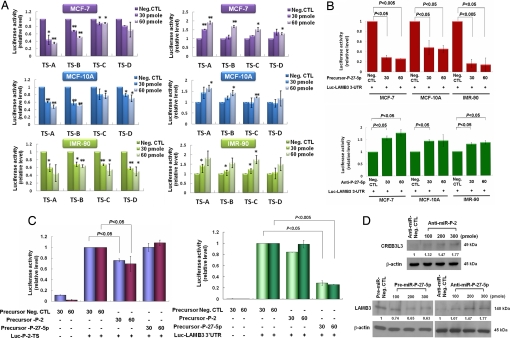Fig. 3.
Functional target validation of novel mature miRNAs by luciferase assay and immunoblotting using their mimics and inhibitors. The MCF-7, MCF-10A, and IMR-90 cell lines each were transfected with 30–60 pmol PremiR or anti-miR miRNAs of P-2 or P-27–5p. The three different cell lines were cotransfected with luciferase reporter constructs bearing a P-2 target sequence on CREB3L3 3′ UTR or a P-27–5p target sequence on LAMB3 3′ UTRs. The cells were assayed for luciferase activity after transfection for 48 h. (A) Use of P-2 mimics (Left) or inhibitors (Right) showed that P-2 can bind to four possible TSs (TS-A, TS-B, TS-C, and TS-D in Fig. S6) in CREB3L3 3′ UTR in three cell lines (*, P < 0.05, **, P < 0.001). (B) The luciferase activity of cells transfected with P-27–5p mimic was decreased and that transfected with anti-P-27–5p was increased in the three types of cells. (C) Luciferase reporter-based assay was also used to determine miRNA specificity. P-2 and P-27–5p could target specifically to CREB3L3 and LAMB3, respectively. (D) MCF-7 cells were transfected with 100–300 pmol mimic or inhibitor. Protein expression of LAMB3 was decreased after treatment with P-27–5p mimic and increased after treatment with P-27–5p inhibitor for 48 h. CREB3L3 was increased after treatment with P-2 inhibitor.

